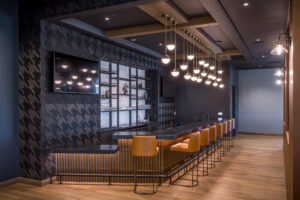You’re invited to a virtual tour of the Slawson Family Asian Big Cat Trek with Dr. Jeff Ettling, Director of Sedgwick County Zoo. Home to Amur Leopards, Snow Leopards, Amur Tigers, and Red Pandas, the Slawson Family Asian Big Cat Trek is a complex habitat designed for flexibility, exceptional animal welfare, and breeding. Built in two phases but seamlessly integrated, this exhibit provides variety through animal rotation and is evidence that an enriching experience for both guests and animals can be achieved while managing cost.
The Slawson Family Asian Big Cat Trek was designed by TESSERE Zoos.
A special thank you to Dr. Jeff Ettling and his team at the Sedgwick County Zoo for producing this virtual tour experience!
Key Features & Innovations:
1. Committed to Population Sustainability
With four public-facing leopard habitats and ample behind-the-scenes space that includes two outdoor areas, the Slawson Family Asian Big Cat Trek can house up to ten cats. In the early stages of design, the Sedgwick County Zoo pledged not to compromise on space for animals and instead sought ways to maximize available space and resources. For example, local limestone was saved during excavation to provide interest and elevation in the habitats instead of artificial rock work, realizing considerable cost and space savings.
2. Seamlessly Integrated
Though the Slawson Family Asian Big Cat Trek was built in two phases, you’d never know it! Close attention to detail and strategic updates to existing habitats provide a seamless guest experience. Originally built in 2009, a new 3-sided, floor-to-ceiling viewing window now juts out into the tiger habitat, leaving guests feeling immersed and surrounded; nose to nose with the tigers.
3. Crossover Connections Offer Flexibility
A network of netted crossover paths connects habitats, providing variety for leopards and guests. The cats’ affinity for these spaces has been striking and they often choose to lay overhead, observing the Zoo and its guests from above. This has allowed the animal care team to utilize the crossovers as temporary shift areas, expanding opportunities for outdoor training and servicing of habitats. Considering the cats’ susceptibility to COVID-19, this has been an invaluable unexpected asset during the pandemic, alongside the ability to provide cats with 24-hour access to outdoor habitats.
Not only for leopards, the overhead crossovers were designed to facilitate care and cleaning. Members of the animal care & veterinary team were involved in habitat design from the onset and informed animal welfare and operational decisions. Based on their feedback, a section of overhead shifts was raised to a height that would allow keepers to walk through rather than crawl or crouch, creating a better environment for both people and animals.
4. “Turning It Inside Out” With Interpretation
Developing interpretives for the Slawson Family Asian Big Cat Trek was a team effort at Sedgwick County Zoo. An interdepartmental group started by identifying intended outcomes and collaborated to develop an engaging interpretive experience. In addition to conservation messaging, the team tells the compelling story of exceptional care and welfare through graphics that explain the exhibit’s configuration and connections, temperature regulation, choice & control, enrichment, and training. Sedgwick County Zoo intentionally “turns it inside out” with full transparency about the way animals are cared for at the Zoo.




